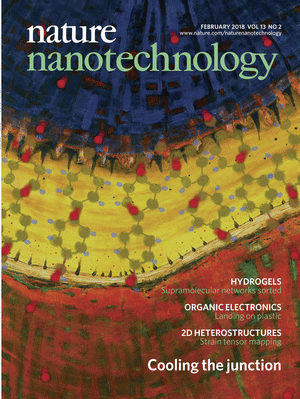Team Employs Chemistry to Engineer Optical Material
 Feb. 7, 2018 - A novel way to create optical materials using chemistry instead of traditional etching technologies has caught the eye of editors at Nature Nanotechnology, a monthly peer-reviewed scientific journal. The research, a multidisciplinary collaboration among UC Irvine material scientists, civil engineers, electrical engineers, chemists and physicists, was chosen as a highlight recently on the journal’s online site.
Feb. 7, 2018 - A novel way to create optical materials using chemistry instead of traditional etching technologies has caught the eye of editors at Nature Nanotechnology, a monthly peer-reviewed scientific journal. The research, a multidisciplinary collaboration among UC Irvine material scientists, civil engineers, electrical engineers, chemists and physicists, was chosen as a highlight recently on the journal’s online site.
Plasmonics: Chemistry in the Gap, is a recap of the group’s paper: Driving Chemical Reactions in Plasmonic Nanogaps with Electrohydrodynamic Flow, which was submitted to ASC Nano. The work details an approach to forcing nanoparticles to chemically react and link to each other in an orderly way, creating highly intense optical “gaps” between them. These gaps can be used in sensors to identify bacteria and other molecules, and can comprise engineered surfaces with applications in healthcare, military and consumer materials.
Researchers add electrodes in solution during nanoparticle assembly, creating a whirlpool-like force on the surface. Called electric hydrodynamic (EHD) flow, this force pushes the particles closer together and promotes chemical crosslinking between nanoparticles. EDH flow also proved to override Brownian motion, the theory that very small particles in fluid will move randomly.
Chemical crosslinking ensures the nanoparticles are separated by a one-nanometer gap. The tiny gaps have extremely high electric fields – the smaller the gap, the higher the electric field – increasing the signal in the sensor. The 2-square-millimeter device surfaces created by the researchers contain so many of these high-intensity gaps, the odds increase exponentially that the sensors can optically detect very small quantities of molecule in samples.
“We have lots of these gaps on the surface, so there’s high probability that a molecule will find its way into a gap so we can detect it,” said principle investigator Regina Ragan, whose graduate student Will Thrift is first author on the paper.
The process can identify bacteria biofilm formation in as little as three hours, without requiring additional culturing. This innovative technology could ensure sterilization of medical devices, signal early infection and monitor the progress of wound-healing.
The surfaces can also be used in metamaterials, including camouflage.
Civil engineer Mohammad Javad (MJ) Abdolhosseini Qomi collaborated with Ragan’s group by running simulations to test and reinforce the group’s findings. He had to surmount speculation that the EHD flow could compete with Brownian motion for nanoscale particles.
“We had to show that if we bring them together and keep them close to each other, this linking reaction will happen,” Qomi says. “It takes time and it takes an outside force to make it happen; the EHD flow was really the mechanism that did this.”
Next steps in the research include using machine-learning techniques for rapid analysis of the optical data, and applying the self-assembly techniques to optical-magnetic surfaces.
Other collaborators on the project were Allon I. Hochbaum and Cuong Q. Nguyen (chemical engineering and materials science), Filippo Capolino and Mahsa Darvishzadeh-Varcheie (electrical engineering and computer science), Siavash Zare (civil and environmental engineering), Nicholas Sharac and Torin J. Dupper (chemistry) and Robert N. Sanderson (physics and astronomy).
- Anna Lynn Spitzer
